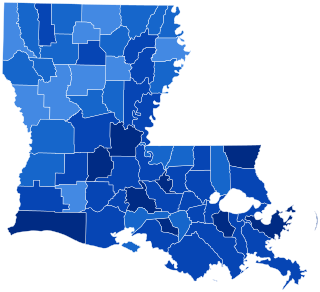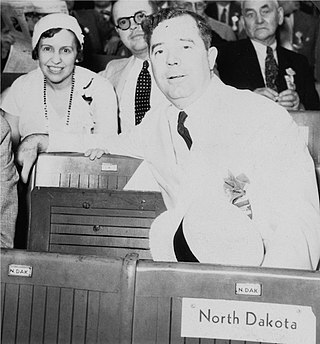
The 1936 United States presidential election was the 38th quadrennial presidential election, held on Tuesday, November 3, 1936. In the midst of the Great Depression, incumbent Democratic President Franklin D. Roosevelt defeated Republican Governor Alf Landon of Kansas. Roosevelt won the highest share of the popular vote (60.3%) and the electoral vote since the largely uncontested 1820 election. The sweeping victory consolidated the New Deal Coalition in control of the Fifth Party System.

Huey Pierce Long Jr., nicknamed "The Kingfish", was an American politician who served as the 40th governor of Louisiana from 1928 to 1932 and as a United States senator from 1932 until his assassination in 1935. He was a left-wing populist member of the Democratic Party and rose to national prominence during the Great Depression for his vocal criticism of President Franklin D. Roosevelt and his New Deal, which Long deemed insufficiently radical. As the political leader of Louisiana, he commanded wide networks of supporters and often took forceful action. A controversial figure, Long is celebrated as a populist champion of the poor or, conversely, denounced as a fascistic demagogue.

Russell Billiu Long was an American Democratic politician and United States Senator from Louisiana from 1948 until 1987. Because of his seniority, he advanced to chairman of the Senate Finance Committee, serving for fifteen years, from 1966 to 1981, during the implementation of President Lyndon Johnson's Great Society and War on Poverty programs. Long also served as Assistant Majority Leader from 1965 to 1969.

Francis Everett Townsend was an American physician and political activist in California. In 1933, he devised an old-age pension scheme to help alleviate the Great Depression. Known as the "Townsend Plan", this proposal would pay every person over age 60 $200 per month, with the requirement it all be spent quickly. It was never enacted but the popularity of the Plan influenced Congress to start the Social Security system, which involved much smaller amounts. The Plan was organized by real estate salesman Robert Clements, who made Townsend only a figurehead while the Plan expanded to thousands of clubs in many states. Townsend was born just outside Fairbury, Illinois, where he is memorialized by a post office named in his honor.
Arthur Vidrine was a physician from Ville Platte, the seat of Evangeline Parish in south Louisiana, who was best known for having operated on Democratic U.S. Senator Huey Pierce Long Jr., after Long was shot on September 8, 1935, in the Louisiana State Capitol in Baton Rouge, presumably by another young physician, Carl A. Weiss.

Gerald Lyman Kenneth Smith was an American clergyman, politician and organizer known for his populist and far-right demagoguery. A leader of the populist Share Our Wealth movement during the Great Depression, afterward he became known for far-right causes including the Christian Nationalist Crusade, which he founded in 1942. He founded the America First Party in 1943 and was its 1944 presidential candidate, winning fewer than 1,800 votes. He was a preeminent antisemite and a white supremacist.
The Townsend Plan, officially the Old-Age Revolving Pensions (OARP) plan, was a September 1933 proposal by California physician Francis Townsend for an old-age pension in response to the Great Depression, leading to a social and political movement. At its peak, the OARP advocacy group claimed more than 750,000 members. The movement demonstrated nationwide demand for old-age pensions, leading Congress and President Franklin D. Roosevelt to adopt a national Social Security policy, though Townsend's original plan called for greater benefits to a greater number of people than Social Security provided.

Richard Webster Leche was an American attorney, judge, and politician, elected as the 44th Governor of the U.S. state of Louisiana. He served from 1936 until 1939, when he resigned. Convicted on federal charges of misuse of federal funds, Leche was the first Louisiana chief executive to be imprisoned.
The Second New Deal is a term used by historians to characterize the second stage, 1935–36, of the New Deal programs of President Franklin D. Roosevelt. The most famous laws included the Emergency Relief Appropriation Act, the Banking Act, the Wagner National Labor Relations Act, the Public Utility Holding Companies Act, the Social Security Act, and the Wealth Tax Act.

The 1928 Louisiana gubernatorial election was held on April 17, 1928. Like in most Southern states between the Reconstruction era and the civil rights movement, Louisiana's Republican Party was virtually nonexistent in terms of electoral support. This meant that the Democratic primary held on January 17 was essentially the real contest to decide the governor, as winning the Democratic nomination would be tantamount to election as governor.
The National Union for Social Justice (NUSJ) was a United States political movement formed in 1934 by Charles Coughlin, a Catholic priest and radio host. It heavily criticized communism, capitalism, and the administration of Franklin D. Roosevelt, while also advocating for the nationalization of utilities and banks. The organization dissolved in 1937 after the political party it sponsored, the Union Party, drew less than two percent of the popular vote in the 1936 United States presidential election.

The 1944 United States presidential election in Louisiana took place on November 7, 1944, as part of the 1944 United States presidential election. State voters chose ten representatives, or electors, to the Electoral College, who voted for president and vice president.

The 1940 United States presidential election in Louisiana took place on November 5, 1940, as part of the 1940 United States presidential election. State voters chose ten representatives, or electors, to the Electoral College, who voted for president and vice president.

The 1936 United States presidential election in Louisiana took place on November 3, 1936, as part of the 1936 United States presidential election. Louisiana voters chose ten representatives, or electors, to the Electoral College, who voted for president and vice president.

On September 8, 1935, United States senator and former Louisiana governor Huey Long was fatally shot at the Louisiana State Capitol in Baton Rouge, Louisiana. Long was an extremely popular and influential politician at the time, and his death eliminated a possible 1936 presidential bid against incumbent Franklin D. Roosevelt.

The political views of Huey P. Long have presented historians and biographers with some difficulty. While most say that Louisiana Governor and Senator Huey Long was a populist, little else can be agreed on. Huey Long's opponents, both during his life and after, often drew connections between him and his ideology and far-left and right political movements, comparing it to everything from European Fascism, Stalinism, and later McCarthyism. When asked about his own political personality, Long simply replied: "Oh, hell, say that I’m sui generis and let it go at that." Writer Robert Penn Warren said "my guess is he was a remarkable set of contradictions."
"Every Man a King" is a song cowritten by Louisiana's Governor and United States Senator Huey Long and Castro Carazo. Long was known for his political slogan "Every man a king," which is also the title of his 1933 autobiography and the catch-phrase of his Share Our Wealth proposal during the Great Depression. The song's lyrics include the lines "With castles and clothing and food for all/ All belongs to you". The song was co-written in 1935 by Huey Long and Castro Carazo, the band director of Louisiana State University, a former orchestra leader at the Roosevelt Hotel in New Orleans brought to LSU by Long himself.

The Cotton-Holiday was a 1931 proposal by Louisiana Governor and US Senator-elect Huey Long to alleviate a surplus of cotton. The holiday would have banned cotton production in 1932, decreasing supply and raising prices. It has been credited as the first suggestion of artificial scarcity as a solution to the Great Depression.

Huey Long, the former governor of Louisiana, served in the United States Senate from 1932 until his assassination in 1935. A powerful figure, Long was integral in Franklin Roosevelt's 1932 Democratic Nomination and the election of the first woman, Hattie Caraway, to the US Senate. He was investigated for election discrepancies regarding the election of his friend John H. Overton, but no evidence of fraud was found. He proposed sweeping legislation, known as the Share Our Wealth plan, to end the Great Depression. Long often used filibusters to prevent or slow the passage of New Deal legislation.
Huey Long, governor of Louisiana and US Senator, has inspired or been portrayed in numerous cultural works. He has served as the template for fascistic politicians in novels like It Can't Happen Here (1935), A Lion Is in the Streets (1945), and All the King's Men (1946). The latter two were adapted into Oscar-winning films.


















